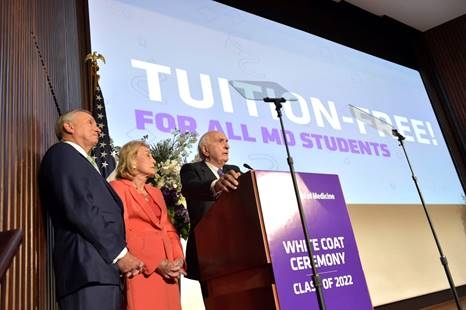You have /5 articles left.
Sign up for a free account or log in.

NYU School of Medicine leaders announced tuition-free education at a White Coat ceremony Thursday.
Photo credit: NYU Langone Health
As worries persist about high medical education costs and new doctors shouldering staggering debt loads, leaders of the New York University School of Medicine on Thursday announced new full-tuition scholarships for current and future students.
The scholarships cover M.D. students at the NYU School of Medicine, where the sticker price is $55,018. About 440 students across all classes will be covered at a total cost of $24 million annually.
NYU has for years been working to raise hundreds of millions of dollars in endowed funds necessary to pay for the scholarships. It is not the first prominent institution to announce a medical school affordability initiative in recent memory, but its new program stands out for its high level of funding, its scope and because it has been in the works for quite some time.
“We were planning this for 11 years,” said Dr. Rafael Rivera, associate dean for admissions and financial aid at the NYU School of Medicine. “This is not an issue that’s solely NYU’s problem. We hope medical schools across the country will figure out additional ways of addressing it.”
Several other medical schools have taken significant steps to cover medical school costs in recent decades. In 2008, the young Cleveland Clinic Lerner College of Medicine at Case Western Reserve University said it would pay tuition for its 32 entering students. Today, the college -- which remains much smaller than NYU -- provides full scholarships covering tuition and fees for all students.
The University of California, Los Angeles, in 2012 announced a merit-based scholarship that covers the full cost of attendance for in- or out-of-state students. That scholarship covers almost 20 percent of entering medical students every year.
NYU’s uptown rival, Columbia University, announced in April the launch of a new scholarship program for students at its college of physicians and surgeons. That program, for students who qualify for financial aid, replaces loans with scholarships. About 20 percent of students were expected to demonstrate enough need to receive full scholarships under that program. Columbia reported launching its program ahead of schedule after donors quickly built upon a $150 million scholarship fund endowment gift announced in December.
The NYU scholarship is expected to cover more students than those efforts.
“This effort is unique, and it’s big,” said Julie Fresne, senior director of student financial services and debt management strategies at the Association of American Medical Colleges. “How this particular offering from NYU is different from other ones is this offers a tuition scholarship for every single student, regardless of whether or not they’re the top two academically in the class or the top two who have the most financial aid.”
NYU will need about $600 million in endowed funds in order to support its full-tuition scholarships into the future. The university has raised about $450 million toward that goal, and leaders are confident in continued progress after they were able to raise $240 million in the last nine months alone.
“We’ve been pretty deliberate and focused on making sure that we could do this,” said Dr. Robert I. Grossman, dean of the NYU School of Medicine and CEO of NYU Langone Health. “We’ve had amazing donors, philanthropists, et cetera, who actually believe this is a very significant issue and problem. Through their generosity, we are solving that problem.”
The already steep cost of a medical education has continued to rise in the United States in recent years. Tuition, fees and health insurance increased for most students by about 3 percent in the 2017-18 academic year, according to statistics compiled by the medical colleges' association. Charges at private institutions averaged $57,000 for residents and $59,000 for nonresidents. Charges at public institutions averaged about $36,000 for residents and $60,000 for nonresidents.
High costs have for years stoked concerns about how debt affects aspiring doctors. Leaders worry some of the best and the brightest students, particularly those from poor and immigrant communities, are dissuaded from attending medical school at all. Others fear that the need to pay for medical school dissuades many of the students who do attend from pursuing practices in fields where they are most needed, like primary care or pediatrics, and from locating in poor regions where doctors are scarce. Instead, they worry, the current economics of medical school effectively encourage students to enter high-paying specialties and set up practices in wealthy regions.
AAMC statistics make clear just how heavy the debt burden is on doctors: three-quarters of the class of 2017 had debt. Among those who had borrowed, median indebtedness rose 1 percent, to $192,000. About half of students, 48 percent, borrowed $200,000 or more -- and 46 percent planned to enter a loan forgiveness or repayment program.
Those who attended private institutions owed more than the class as a whole, although a slightly lower percentage, 72 percent, borrowed. Those who had borrowed to attend private institutions posted a median debt of $202,000. More than half, 57 percent, owed $200,000 or more. About a fifth, 21 percent, owed $300,000 or more.
NYU’s new scholarship will not cover costs besides tuition -- like living expenses, fees and health insurance. The university still expects first-year students to have costs totaling about $27,000.
But leaders say about 10 percent of each class will receive merit scholarships covering the full cost of attendance. While many students will still have to pay costs associated with their medical education, leaders say it is important that none will have to worry about tuition.
It will be worth watching how the already highly rated NYU School of Medicine’s admissions metrics change under the scholarship. The medical school has no plans to expand its class sizes beyond current levels. So it could very well become an even more sought-after seat for price-conscious students.
Medical education is difficult and has in many cases shifted away from an inpatient setting, making extremely large classes unrealistic, Grossman said. NYU’s goal is to “produce the best medical education we can for our students.”
While many hope lower costs will lead to more general practitioners, covering the cost of tuition isn’t necessarily an attempt to encourage any particular student to choose any specialty, according to NYU leaders.
“What we’re doing is providing freedom of choice,” Grossman said. “The freedom of choice enables students who, by and large, are committed and altruistic to go with their passion. If they want to do primary care, they’re not going to be burdened by debt.”
NYU touts other efforts designed to make medical school more affordable, like an accelerated three-year curriculum, which it decided in 2013 to offer. The idea is that doctors can begin practicing earlier with less debt.
“We talked about two ways of reducing debt,” Rivera said. “One is decreasing the cost of attendance for any given year, like we’ve done with the tuition-free initiative. The other is to shorten medical school.”
It’s possible that NYU’s new scholarship and some of the other recent scholarships announced at other medical schools are the start of a renewed effort to cover medical school costs. But it’s not that simple. It will remain expensive for institutions to educate future doctors, and not every medical school has the fund-raising expertise, history or deep donor pool needed to raise hundreds of millions of dollars in endowed funds for comprehensive scholarships.
“I would like to hope that there’s an ongoing momentum,” said Fresne, of the AAMC. “I think most schools would love to be in this position. Perhaps they will look to NYU as a model of how to make something like this happen. But, again, it takes a lot of pieces coming together to be able to make something like this happen. Some schools have larger endowments than other schools that may be newer and not have as far of a pool of alumni to call upon.”




